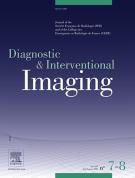Differentiation between adrenocortical carcinoma and lipid-poor adrenal adenoma using a multiparametric MRI-based diagnostic algorithm - 28/09/24

Highlights |
• | A diagnostic algorithm combining signal intensity index on chemical-shift imaging and apparent diffusion coefficient value on diffusion-weighted imaging helps discriminate between lipid-poor adrenal adenoma and adrenocortical carcinoma with 75% accuracy. |
• | Best sensitivity (96%) for the diagnosis of adrenocortical carcinoma vs. lipid-poor adrenal adenoma is obtained using the association of the diagnostic algorithm with adrenal lesion size. |
Abstract |
Purpose |
The purpose of this study was to evaluate the capabilities of multiparametric magnetic resonance imaging (MRI) in differentiating between lipid-poor adrenal adenoma (LPAA) and adrenocortical carcinoma (ACC).
Materials and methods |
Patients of two centers who underwent surgical resection of LPAA or ACC after multiparametric MRI were retrospectively included. A training cohort was used to build a diagnostic algorithm obtained through recursive partitioning based on multiparametric MRI variables, including apparent diffusion coefficient and chemical shift signal ratio (i.e., tumor signal intensity index). The diagnostic performances of the multiparametric MRI-based algorithm were evaluated using a validation cohort, alone first and then in association with adrenal tumor size using a cut-off of 4 cm. Performances of the diagnostic algorithm for the diagnosis of ACC vs. LPAA were calculated using pathology as the reference standard.
Results |
Fifty-four patients (27 with LPAA and 27 with ACC; 37 women; mean age, 48.5 ± 13.3 [standard deviation (SD)] years) were used as the training cohort and 61 patients (24 with LPAA and 37 with ACC; 47 women; mean age, 49 ± 11.7 [SD] years) were used as the validation cohort. In the validation cohort, the diagnostic algorithm yielded best accuracy for the diagnosis of ACC vs. LPAA (75%; 46/61; 95% CI: 55–88) when used without lesion size. Best sensitivity was obtained with the association of the diagnostic algorithm with tumor size (96%; 23/24; 95% CI: 80–99). Best specificity was obtained with the diagnostic algorithm used alone (76%; 28/37; 95% CI: 60–87).
Conclusion |
A multiparametric MRI-based diagnostic algorithm that includes apparent diffusion coefficient and tumor signal intensity index helps discriminate between ACC and LPAA with high degrees of specificity and accuracy. The association of the multiparametric MRI-based diagnostic algorithm with adrenal lesion size helps maximize the sensitivity of multiparametric MRI for the diagnosis of ACC.
Le texte complet de cet article est disponible en PDF.Keywords : Adrenal gland disease, Adrenal gland neoplasm, Adrenocortical carcinoma, Diagnostic algorithm, Magnetic resonance imaging
List of abbreviations : AA, ACC, ADC, AL, ALR, APW, ASR, CI, CT, DWI, FS, GBCA, HASTE, HU, IP, IQR, LPAA, MRI, OP, PET, ROI, RPW, SD, SI, SII, TSE
Plan
Vol 105 - N° 10
P. 355-363 - octobre 2024 Retour au numéroBienvenue sur EM-consulte, la référence des professionnels de santé.
L’accès au texte intégral de cet article nécessite un abonnement.
Déjà abonné à cette revue ?

